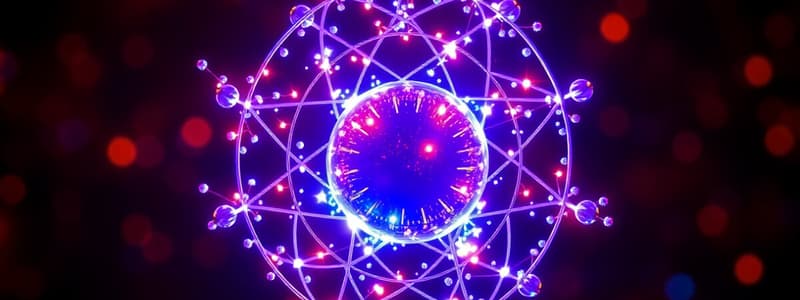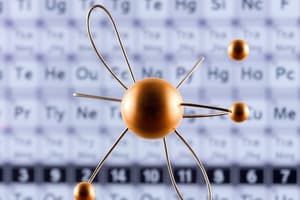Podcast
Questions and Answers
What is the correct subshell electronic configuration for sodium (Na) using the noble gas notation?
What is the correct subshell electronic configuration for sodium (Na) using the noble gas notation?
- [He] 2s^2
- [Ne] 2s^2 2p^6 3s^1
- [Ne] 3s^1 (correct)
- [Ar] 4s^1
Which element is represented by the electronic configuration 2, 8, 11, 2?
Which element is represented by the electronic configuration 2, 8, 11, 2?
- Titanium (Ti)
- Aluminum (Al) (correct)
- Scandium (Sc)
- Vanadium (V)
When following the order of filling subshells, which subshell is filled after 4s?
When following the order of filling subshells, which subshell is filled after 4s?
- 3p
- 4p
- 4d
- 3d (correct)
What is the maximum number of electrons that can be accommodated in the 's' subshell?
What is the maximum number of electrons that can be accommodated in the 's' subshell?
How many maximum electrons can be accommodated in the 'p' subshell?
How many maximum electrons can be accommodated in the 'p' subshell?
In the context of electron configuration, what order do electrons fill subshells?
In the context of electron configuration, what order do electrons fill subshells?
What is the electronic configuration of the carbon atom?
What is the electronic configuration of the carbon atom?
Which statement correctly describes the distribution of electrons in the fourth shell?
Which statement correctly describes the distribution of electrons in the fourth shell?
Which subshell holds the least maximum number of electrons?
Which subshell holds the least maximum number of electrons?
Which of the following is true regarding the filling order of subshells?
Which of the following is true regarding the filling order of subshells?
What specifies the group number of elements in the s block?
What specifies the group number of elements in the s block?
Which of the following elements does NOT belong to the s block?
Which of the following elements does NOT belong to the s block?
What is a characteristic of alkali and alkaline earth metals?
What is a characteristic of alkali and alkaline earth metals?
How many electrons are present in the last s subshell of alkaline earth metals?
How many electrons are present in the last s subshell of alkaline earth metals?
In the context of the periodic table, which group represents alkali metals?
In the context of the periodic table, which group represents alkali metals?
Which statement about the electronic configuration of s block elements is true?
Which statement about the electronic configuration of s block elements is true?
What distinguishes the actinoids from the lanthanoids?
What distinguishes the actinoids from the lanthanoids?
What determines the maximum number of electrons in the last s subshell?
What determines the maximum number of electrons in the last s subshell?
What characteristic of transition elements allows them to display variable oxidation states?
What characteristic of transition elements allows them to display variable oxidation states?
Which of the following is a property commonly associated with transition elements?
Which of the following is a property commonly associated with transition elements?
Which of the following compounds is known to exhibit color due to the presence of transition elements?
Which of the following compounds is known to exhibit color due to the presence of transition elements?
What is the role of a catalyst in a chemical reaction?
What is the role of a catalyst in a chemical reaction?
Which transition element compound among the following is often used in laboratories?
Which transition element compound among the following is often used in laboratories?
What is the stable electronic configuration of chromium?
What is the stable electronic configuration of chromium?
Which of the following statements is true regarding the stability of electronic configurations?
Which of the following statements is true regarding the stability of electronic configurations?
Identify the correct electron configuration for copper from the options provided.
Identify the correct electron configuration for copper from the options provided.
How many electrons can the d subshell accommodate?
How many electrons can the d subshell accommodate?
What is indicated by the presence of a half-filled or fully filled d subshell regarding an atom?
What is indicated by the presence of a half-filled or fully filled d subshell regarding an atom?
If the electronic configuration is 1s2 2s2 2p6 3s2 3p6 3d5 4s2, how many shells are present?
If the electronic configuration is 1s2 2s2 2p6 3s2 3p6 3d5 4s2, how many shells are present?
Which subshell receives the last electron in the configuration of chromium?
Which subshell receives the last electron in the configuration of chromium?
What would be the total number of electrons in an atom with the configuration 1s2 2s2 2p6 3s2 3p6 3d10 4s1?
What would be the total number of electrons in an atom with the configuration 1s2 2s2 2p6 3s2 3p6 3d10 4s1?
What is the correct electronic configuration order for scandium?
What is the correct electronic configuration order for scandium?
Which subshell comes after 3p in the electronic configuration of scandium?
Which subshell comes after 3p in the electronic configuration of scandium?
How many electrons are present in the 3d subshell of scandium based on its electron configuration?
How many electrons are present in the 3d subshell of scandium based on its electron configuration?
What is the total number of electrons in the first three shells of scandium?
What is the total number of electrons in the first three shells of scandium?
In electronic configuration, what does the notation '2p³' represent?
In electronic configuration, what does the notation '2p³' represent?
Which of the following is true regarding the order in which electrons fill subshells?
Which of the following is true regarding the order in which electrons fill subshells?
What is the last subshell filled in the electronic configuration of scandium?
What is the last subshell filled in the electronic configuration of scandium?
Which of these describes the filling of the 4s subshell in relation to the 3d subshell?
Which of these describes the filling of the 4s subshell in relation to the 3d subshell?
What is the total number of electrons in the electronic configuration for scandium before reaching the 4s subshell?
What is the total number of electrons in the electronic configuration for scandium before reaching the 4s subshell?
Flashcards
Subshell Electron Capacity
Subshell Electron Capacity
The maximum number of electrons that can occupy a specific subshell (s, p, d, or f) in an atom.
What is the maximum number of electrons in the 's' subshell?
What is the maximum number of electrons in the 's' subshell?
The 's' subshell can hold a maximum of 2 electrons.
What is the maximum number of electrons in the 'p' subshell?
What is the maximum number of electrons in the 'p' subshell?
The 'p' subshell can hold a maximum of 6 electrons.
What is the maximum number of electrons in the 'd' subshell?
What is the maximum number of electrons in the 'd' subshell?
Signup and view all the flashcards
What is the maximum number of electrons in the 'f' subshell?
What is the maximum number of electrons in the 'f' subshell?
Signup and view all the flashcards
Electronic Configuration
Electronic Configuration
Signup and view all the flashcards
Subshell Electronic Configuration
Subshell Electronic Configuration
Signup and view all the flashcards
What is the electronic configuration of carbon?
What is the electronic configuration of carbon?
Signup and view all the flashcards
What is the preceding noble gas?
What is the preceding noble gas?
Signup and view all the flashcards
What is the preceding noble gas for Sodium?
What is the preceding noble gas for Sodium?
Signup and view all the flashcards
What is the subshell electronic configuration of Sodium?
What is the subshell electronic configuration of Sodium?
Signup and view all the flashcards
What is an electronic configuration?
What is an electronic configuration?
Signup and view all the flashcards
How to write subshell electronic configuration?
How to write subshell electronic configuration?
Signup and view all the flashcards
Transition elements
Transition elements
Signup and view all the flashcards
Variable Oxidation States
Variable Oxidation States
Signup and view all the flashcards
Catalyst
Catalyst
Signup and view all the flashcards
Coloured Compounds
Coloured Compounds
Signup and view all the flashcards
Catalytic Property of Transition Elements
Catalytic Property of Transition Elements
Signup and view all the flashcards
Periodic table
Periodic table
Signup and view all the flashcards
Atomic number
Atomic number
Signup and view all the flashcards
Electrons
Electrons
Signup and view all the flashcards
Electron shells
Electron shells
Signup and view all the flashcards
Electron subshells
Electron subshells
Signup and view all the flashcards
Electron filling
Electron filling
Signup and view all the flashcards
Subshell
Subshell
Signup and view all the flashcards
Orbital
Orbital
Signup and view all the flashcards
Electron filling order
Electron filling order
Signup and view all the flashcards
What is the maximum number of electrons in a d subshell?
What is the maximum number of electrons in a d subshell?
Signup and view all the flashcards
What makes a d subshell more stable?
What makes a d subshell more stable?
Signup and view all the flashcards
What is the electronic configuration of Chromium (Cr) and why?
What is the electronic configuration of Chromium (Cr) and why?
Signup and view all the flashcards
What is the electronic configuration of Copper (Cu) and why?
What is the electronic configuration of Copper (Cu) and why?
Signup and view all the flashcards
Identify the subshells and the last electron's location with this configuration: 1s² 2s² 2p⁶ 3s² 3p⁶ 4s²
Identify the subshells and the last electron's location with this configuration: 1s² 2s² 2p⁶ 3s² 3p⁶ 4s²
Signup and view all the flashcards
How many electrons and what is the atomic number of an atom with the configuration 1s² 2s² 2p⁶ 3s² 3p⁶ 4s²?
How many electrons and what is the atomic number of an atom with the configuration 1s² 2s² 2p⁶ 3s² 3p⁶ 4s²?
Signup and view all the flashcards
How many shells are present in an atom with the configuration 1s² 2s² 2p⁶ 3s² 3p⁶ 4s²?
How many shells are present in an atom with the configuration 1s² 2s² 2p⁶ 3s² 3p⁶ 4s²?
Signup and view all the flashcards
s block elements
s block elements
Signup and view all the flashcards
Alkali metals
Alkali metals
Signup and view all the flashcards
Alkaline earth metals
Alkaline earth metals
Signup and view all the flashcards
Why are they called 's block elements'?
Why are they called 's block elements'?
Signup and view all the flashcards
Relationship between 's subshell electrons' and group number
Relationship between 's subshell electrons' and group number
Signup and view all the flashcards
Last subshell of an element
Last subshell of an element
Signup and view all the flashcards
Study Notes
Periodic Table and Electronic Configuration
- The periodic table classifies elements based on their atomic structure.
- The basis for classification is the atomic structure of elements.
- Atomic structure, through experiments and assumptions, forms the basis of understanding elements.
Electronic Configuration
- Electrons orbit the nucleus in shells, with each shell having sub-shells or orbitals (s, p, d, f).
- The maximum number of electrons that can occupy an orbital is 2.
- s sub-shells have 1 orbital; p sub-shells have 3 orbitals, d sub-shells have 5 orbitals, and f sub-shells have 7 orbitals.
- Each sub-shell has a specific shape and a fixed energy level.
- Electronic configurations are written in increasing order of energy levels, starting from 1s.
- The first shell, 'K', has one subshell. The second shell, 'L', has 2; the third shell, 'M', has 3; and the fourth shell, 'N', has 4 subshells.
Relation Between Electronic Configuration and Periodic Table
- The electronic configuration of an element helps determine its position in the periodic table.
- The outermost shell's electrons influence the element's properties.
- Elements with similar electronic configurations are grouped together in the periodic table.
Filling of Electrons in Subshells
- Electrons fill orbitals or subshells in order of increasing energy levels.
- The filling order is 1s, 2s, 2p, 3s, 3p, 4s, 3d, 4p, 5s, 4d, etc.
- Subshells with lower energy levels are filled first.
- The maximum number of electrons that each subshell (s, p, d, f) can hold is indicated in the table.
Peculiarities of Chromium and Copper Electronic Configurations
- The stable electronic configuration of Chromium (Cr) is 1s² 2s² 2p⁶ 3s² 3p⁶ 3d⁵ 4s¹. This is due to the greater stability of half-filled d orbitals.
- Similar to chromium, Copper (Cu) has an unusual electronic configuration of 1s² 2s² 2p⁶ 3s² 3p⁶ 3d¹⁰ 4s¹. This is again due to the stability of completely filled d orbitals.
Characteristic properties of S block elements
- S-block elements are alkali metals and alkaline earth metals.
- They typically donate electrons in chemical reactions.
- Their oxides and hydroxides are basic.
- They usually have a low ionisation energy
Characteristic properties of P block elements
- P block elements show a wider range of properties and include nonmetals, metalloids, and some metals.
- They have higher ionization energy compared to S-block elements.
- They exhibit various oxidation states, as they can gain or lose electrons.
Characteristic properties of D block elements
- D block elements are also known as transition elements.
- These elements are metals.
- Transition elements often exhibit variable oxidation states.
- These elements are typically good conductors of heat and electricity.
Characteristic Properties of F Block elements
- F block elements include lanthanoids and actinoids.
- The electrons in the penultimate shell are filled in these elements.
- These elements exhibit multiple variables in their oxidation states similar to D block elements.
Studying That Suits You
Use AI to generate personalized quizzes and flashcards to suit your learning preferences.
Related Documents
Description
This quiz explores the classification of elements in the periodic table based on atomic structure and their electronic configurations. Understand the arrangement of electrons in various orbitals and how these configurations relate to the periodic properties of elements.




